Marbles in a Box Poster
Problem
Student Solutions
There are 49 winning lines.
Click below to see four different methods.
Alison's method
- at a vertex
- at the middle of an edge
- in the centre of a face
From a vertex there are $7$ other vertices that you can join to in order to make a winning line. $7 \times 8 = 56$ lines, but this counts each line from both ends, so there are $28$ 'vertex' winning lines.
From the middle of an edge there are $3$ other middles-of-edges that you can join to in order to make a winning line. $3 \times 12 = 36$ lines, but this counts each line from both ends so there are $18$ 'middle of edge' winning lines.
From the centre of each face there is one winning line, joining to the opposite face, so there are $3$ 'centre of face' winning lines.
So in total, there are $28 + 18 + 3 = 49$ winning lines.
James' method
- Diagonal
- Not diagonal
There are $9$ from front to back.
There are $9$ from left to right.
There are $9$ from top to bottom.
Considering the diagonal winning lines:
On each layer there are $2$ diagonal winning lines so:
There are $6$ from front to back.
There are $6$ from top to bottom.
There are $6$ from left to right.
There are $4$ lines from a vertex to a diagonally opposite vertex.
In total, there are $27+18+4=49$ winning lines.
Caroline's method
- along an edge of the cube
- through the middle of a face
- through the centre of the cube
There are $12$ edges on a cube so there are $12$ winning lines along edges.
There are $6$ faces on a cube, and $4$ winning lines that pass through the middle of each face, so there are $24$ winning lines through the middle of faces.
Finally we need to consider the winning lines that go through the centre cube:
vertex to opposite vertex: $4$
middle of edge to middle of opposite edge: $6$
middle of face to middle of opposite face: $3$
In total, there are $12 + 24 + 4 + 6 + 3 = 49$ winning lines.
Grae's method
- in each horizontal plane
- in each vertical plane from left to right
- in each vertical plane from front to back
- in the diagonal planes
On a plane there are $8$ winning lines.
In the cube, there are $3$ horizontal planes, so $8 \times 3 = 24$ winning lines.
There are also $3$ vertical planes going from left to right, but now with only $5$ new winning lines per plane, as the $3$ horizontal lines have already been counted. So $5 \times 3 = 15$ winning lines.
On the $3$ vertical planes going from front to back, we now only have $2$ new (diagonal) winning lines per plane. So $2 \times 3 = 6$ winning lines.
Finally, there are also diagonal planes to consider. There are $4$ winning lines going from corner to diagonally opposite corner.
In total, there are $24 + 15 + 6 + 4 = 49$ winning lines.

